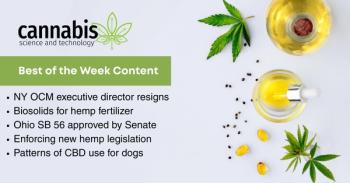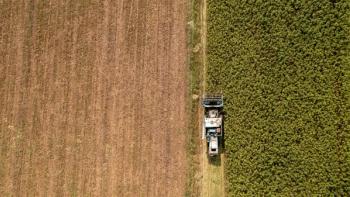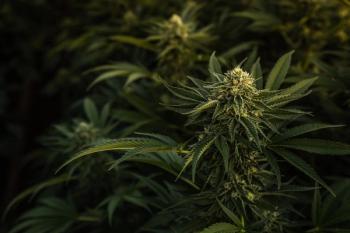
Cannabis Science and Technology
- July/August 2023
- Volume 6
- Issue 6
- Pages: 22-30
Intensity and Spectrum: The Role of Lighting in Vapor Pressure Deficit
This article delves into the aspects of horticultural light intensity and spectra as well as their relative influence on cannabis photosynthesis, photomorphogenesis, and overall yield.
This article delves into the aspects of horticultural light intensity and spectra as well as their relative influence on cannabis photosynthesis, photomorphogenesis, and overall yield. While the manipulation of lighting spectrum and the utilization of sufficient photon density can govern the expression of both major and minor cannabinoids, as well as secondary metabolites such as an array of terpenes, anthocyanins, and flavonoids; these important environmental factors exert considerable influence on plant transpiration and thus a plant’s physiological response to vapor pressure deficit (VPD). In the rapidly expanding cannabis industry, optimizing cultivation practices to maximize crop quality and yield hinges upon a cultivator’s understanding of the intricate interplay between various lighting modalities and VPD. In turn, correct management of VPD alleviates many of the problems that plague controlled environment agriculturists, such as nutritional deficiencies, mold, mildew, and waste of valuable resources, such as CO2, water, and nutrients—the latter of which also results in undesirable capital expenditures.
The art of cannabis and hemp cultivation is reliant on achieving a balance between utilizing stable genetics and the meticulous optimization of various environmental parameters. These factors synergistically contribute to the cultivation outcome, influencing the production of optimal yield and phytochemical composition of the plant varietals involved. To this point, vapor pressure deficit (VPD) emerges as a metric of paramount importance to the overall success of the cultivation environment. VPD is a measurement that represents the deficit between the amount of moisture in the air and the maximum moisture the air can hold (saturation). This metric exerts a profound impact on the transpiration rate within cannabis plants. Transpiration is a physiological process involving the transport of water (along with CO2 and dissolved nutrients) from the roots through the xylem to the leaf (stomata), where it undergoes a phase change into vapor and is subsequently released into the atmosphere.
Although transpiration is primarily driven by the vapor pressure within the plant, it’s important to note that the internal atmosphere of the leaf is not saturated. However, the stomata, which are tiny pores on the leaf, play a crucial role in pressure regulation and thermoregulation. The stomata serve as a gateway between the highly humid internal environment of a plant and the surrounding atmosphere. When humid and dry air come into contact, they attempt to balance each other out, with vapor pressure flowing from high humidity to low. Therefore, if the atmosphere is very hot and dry, water vapor will escape from the leaves at a faster rate, increasing the transpirational demand on cannabis plants and potentially leading to wilting and nutrient deficiencies (see Figure 1a). Conversely, in humid grow rooms where atmospheric conditions are not significantly different from those of the leaf, less water vapor will be able to escape—giving rise to various issues, including the development of fungal diseases, mold, and root rot (see Figure 1b). When the VPD is at an optimal level, plants can more effectively absorb and distribute the nutrients they need for growth and yield (see Figure 1c). Scientifically-minded growers favor VPD as a measure that provides insight in the ever-changing conditions of the air’s moisture-holding capacity at any given temperature.
How to Calculate for VPD in Your Cultivation Environment
The Alduchov and Eskridge equation is an improved form of the Magnus’ formula and is commonly used to estimate the saturation vapor pressure (SVP) and VPD in meteorology. The VPD represents the difference between the saturation vapor pressure (es) and the actual vapor pressure (ea) of the air.
The Alduchov and Eskridge equation for calculating es is as follows in Equation 1:
where es is the saturation vapor pressure in kilopascals (kPa) and T is the temperature in degrees Celsius (°C).
To calculate the VPD, you need to know both the saturation vapor pressure (es) and the actual vapor pressure (ea) of the air. The VPD is then given by Equation 2:
For example, assume the temperature (T) is 25 °C and the actual vapor pressure (ea) is 2.5 kPa. We will calculate the saturation vapor pressure (es) and the VPD. Using the Alduchov and Eskridge equation, we can calculate the saturation vapor pressure (es)
as follows:
Now, we can calculate the vapor pressure deficit (VPD) using the given actual vapor pressure (ea):
In this example, at a temperature of 25 °C, theSVP is approximately 3.17 kPa, and the VPD is approximately 0.67 kPa.
Understanding VPD is crucial for optimizing plant growth and determining appropriate environmental conditions in various applications, including greenhouse cultivation, where maintaining an optimal VPD range is critical for maximizing crop productivity
and quality.
Figure 2 illustrates the recommended VPD levels for cannabis and hemp plants in vegetative stages. Within this chart, the dark green region (0.9-1.1 kPa) represents the most favorable VPD for cultivating cannabis plants. The light green area represents VPD ranges (0.7-0.9 kPa and 1.1-1.3 kPa) that are slightly outside of optimal range yet remain highly desirable. The yellow region indicates VPD levels that require adjustment to achieve optimal plant growth. Lastly, VPD values falling within the white range, lower than 0.5 kPa and higher than 1.7 kPa, are considered detrimental to the overall growth of the plants and require immediate correction.
Figure 3 represents recommended atmospheric VPD values for cannabis or hemp plants in the flowering stage. The green section is the VPD sweet spot and represents the most desirable atmospheric conditions for cannabis cultivation. Purple indicates VPD fringe ranges, but is still more than acceptable. Orange represents VPD conditions requiring adjustment. VPD falling within the white range is detrimental to plant function.
Conversely, the borderline transpiration zone (orange) denotes both elevated and low VPD values ranging from (1.7–2.3 kPa and 0.7–1.0 kPa), respectively. In the elevated orange zone, plants may experience accelerated water loss, increased stress, and lower transpiration rates. In the lower orange zone, plants may experience low transpiration, higher humidity, and may experience mold and mildew issues. The danger zone (white) represents extremely high or low VPD values outside the recommended ranges. Values below 0.4 kPa or above 2.3 kPa indicate potential severe transpirational issues such as excessive humidity levels or nutrient deficiencies due to high transpiration rates and should be corrected immediately.
Why a Lower VPD in Vegetative versus Flower?
For plants in vegetative stages, root mass and stem structure are immature and have relatively little mass. The plant is focusing almost all of its resources to build these two components. Leaves with stomata are few, at least in the early stages of vegetation. A smaller root system contributes less root pressure to the plant system. Lower VPD exhibits more control over water and nutrient uptake for this stage of growth. A more controlled transpiration rate and less water loss occurs, minimizing water and nutrient stress.
During the flowering stage, the root system should be quite large and robust and root pressure should be high. Overall, plant mass during flower is many times that of plants in the vegetative stage of growth. Leaf area will be extensive and as flowers develop, water, CO₂, and nutrient demand will be significant. A higher VPD will provide for greater transpiration to satisfy the plant’s needs. However, it is important to note that extremely high VPDs can result in lower nutrient absorption and many growers increase nutrient levels to compensate. This can result in higher nutrient costs. In addition, higher transpiration may make plants more susceptible to mold, mildew, and root rot. Extremely high VPD may cause stomata to close to preserve resources, which demonstrates the undesirable side-effect of stunting growth.
What Role Does Lighting Play in the VPD Equation?
Horticultural lighting, such as full-spectrum light emitting diode (LED) fixtures impact VPD indirectly by affecting the temperature and humidity in the growing environment. It is a common misconception that LEDs produce very little, or no, heat at all. This is incorrect. LEDs apply less heat to the plants than other technologies if the luminaire and facility thermal management systems are well designed (1). Most LEDs used for illumination purposes convert approximately 22–28% of input power into light that can be used by the plant. To the contrary, high intensity discharge (HID) lighting, such as high pressure sodium (HPS), ceramic metal halide (CMH), and metal halide (MH) lamps convert only 5–10% of their energy consumption into usable light. The rest of the input power for both HID and LED lighting is converted into infrared light (IR), which is felt as heat. Interestingly, HID lighting converts this energy into IR at the lamp (light bulb) itself, while LED waste heat is produced at the silicon junctions of the diodes (1). A properly ventilated LED luminaire will move this thermal radiation away from the plant as the heat rises, whereas HID lighting radiates this IR directly to the plant leaves. Additionally, HID horticultural lighting typically uses non-flammable metallic “hoods” to reflect light towards the plants, which further collects this IR and directs it at the leaves themselves. The bottom line here is that both technologies produce heat that greatly affects VPD, albeit LEDs present significantly less impact on transpiration issues due to lower leaf temperatures and lower VPD than their HID counterparts.
The Influence of Lighting Spectrum on VPD
Lighting spectrum also affects VPD. Red light (~630–760 nm) is known to promote stomatal opening, increasing transpiration rates and potentially elevating VPD. Blue light (wavelengths around 400–500 nm), on the other hand, can have a suppressive effect on stomatal opening, which may reduce transpiration rates and subsequently lower VPD. However, both blue and red light used simultaneously and in the correct ratios can increase VPD dramatically (2).
White LEDs present a unique variable to VPD manipulation. Most LED luminaires on the global market use “full spectrum” white LEDs (Figure 1d). This full spectrum is created by coating a discrete high-intensity blue LED, commonly peaking at 450 nm, with a specially formulated phosphor. When this phosphor is excited by the output of the blue LED, it fluoresces and produces light across a broad spectrum. Since this blue LED’s base frequency (450 nm) is the source of most of the spectral energy produced, its amplitude is usually significant compared to the rest of the spectral radiation produced by the LED. Addition of any supplemental red (discrete) LEDs must take this into account to optimize crop yield and phytochemical production (1).
In plants, red light is primarily detected by phytochrome Pr (phytochrome red) and Pfr (phytochrome far red) photoreceptor proteins, whereas blue light is detected by the photoreceptor proteins cryptochromes and phototropins. The interaction of these phytochromes initiate a signaling cascade within the plant cells, ultimately leading to convergence of these protein signaling pathways, activating ion channels, which changes guard cell turgor pressure (3).
Guard cells are specialized and found in the epidermis of plant leaves and stems. When they are filled with water, or turgid, they stretch the epidermis and create openings in the stomata. When they deflate, the pressure on the plant epidermis is lessened and the stomata close. This opening and closing regulates gas exchange in transpiration and allowing CO2 to enter via the stomata. Guard cell water pressure is controlled by ion movement, specifically, potassium and chloride ions, across the cell membranes. Pumping these ions out of the guard cells causes water to also escape, deflating the guard cells (4,5).
Ion channels are protein channels residing in the cell membranes and they come in two configurations: gated channels, which are triggered by specific stimuli, such as voltage, chemicals, force, and temperature; and open channels, which as you might have guessed, stay open and serve as baseline or “leakage” channels. Upon exposure to red light, phytochrome photoreceptors activate signaling pathways that open potassium ion channels, allowing potassium ions to increase cell pressure and open stomata. The addition of blue light to this red light stimulates ion channel activity, thus increasing stomatal response (6).
Ion pumps use adenosine triphosphate (ATP, the cell’s energy currency) to transport ions across cell membranes. The pumps help maintain cell function, signaling, pressure balancing, and other physiological cell functions. Both red and blue light stimulate changes in ion concentrations and membrane potential that help manage cellular processes (7).
Collectively, the optimal ratio of red to blue light for stomatal opening can vary among different plant species, as well as stage of growth. Some plants exhibit a higher sensitivity to red light especially during flowering, while others have a greater requirement for blue light, especially during propagation and vegetative stages. Determining the ideal balance of red and blue light for specific plant species can maximize the stomatal response, thus having a profound impact on finding the optimal VPD window.
Conclusion
By and large, the ongoing advancements in lighting technology continue to revolutionize indoor cannabis cultivation. Specifically, the importance of lighting spectrum and VPD cannot be overstated in aiming to achieve optimal growth and yield results. Fine tuning the spectral composition of light and maintaining an appropriate VPD within the cultivation environment are vital considerations for growers aiming to maximize their crop's potential. The interplay between red and blue light wavelengths, for instance, impacts the overall VPD, which in turn influences transpiration rates, stomatal conductance, and overall plant health. In simpler terms, maintaining consistent temperature and relative humidity in the cultivation space directly impacts the VPD, which in turn affects plant transpiration and growth. Consequently, a comprehension of the intricate relationship between lighting factors and VPD dynamics is indispensable for cultivators seeking to achieve exceptional outcomes in their cannabis production endeavors.
References
- Manes, R. and Stumpf, T., How to Grow Marijuana with LEDs.1st ed., 2019.
- Inoue, S. and Kinoshita, T., Blue Light Regulation of Stomatal Opening and the Plasma Membrane H+-ATPase. Plant Physiology, 2017, 174(2), 531–538.
- Assmann, S.M. and Jegla, T., Guard Cell Sensory Systems: Recent Insights on Stomatal Responses to Light, Abscisic Acid, and CO2. Current Opinion in Plant Biology, 2016, 33, 157-167.
- Shimazaki et al., Blue light activates the plasma membrane H+-ATPase by phosphorylation of the C-terminus in stomatal guard cells, The EMBO Journal, 2007.
- Mott et al., Blue light inhibition of guard cell anion channels mediated by abscisic acid, Plant Journal, 2008.
- Hille, B., Ion Channels of Excitable Membranes, 2001, 3rd ed.
- Alberts et al., Molecular Biology of the Cell, 2002, 4th ed.
About the Authors
Dr. Zacariah Hildenbrand is a research Professor at the University of Texas at El Paso, the principal founder of Inform Environmental, a partner of Medusa Analytical, and is a director of the Curtis Mathes Corporation (OTC:CMCZ). Hannia Mendoza-Dickey is an MS Chemistry student at the University of Texas at El Paso. Robert J. Manes is with Curtis Mathes Corporation.
Direct correspondence to: zlhildenbrand@utep.edu.
How to Cite This Article
Mendoza-Dickey, H., Manes, R., Hildenbrand, Z., Intensity and Spectrum: The Role of Lighting in Vapor Pressure Deficit, Cannabis Science and Technology, 2023, 6(6), 22-32.
Articles in this issue
over 2 years ago
Why Is Everything Distillate?over 2 years ago
2023 Cannabis Science Conference Fall AgendaNewsletter
Unlock the latest breakthroughs in cannabis science—subscribe now to get expert insights, research, and industry updates delivered to your inbox.





